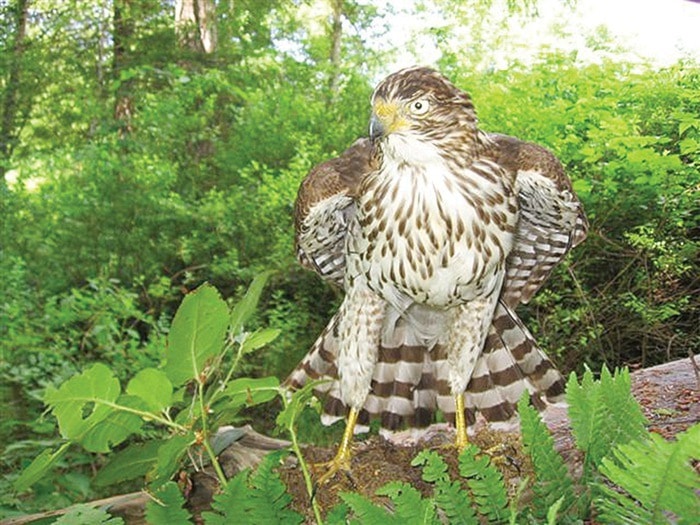The Cooper’s hawk (Accipter cooperii) is among one of the most skillful fliers in the bird world. They are most commonly seen as woodland hawks that zip through dense tree canopies in pursuit of other birds, often at high speed.
Recognized as a medium-sized hawk with broad, rounded wings and a very long tail, the Cooper’s hawks’ head often appears large, with broad shoulders, and a rounded tail, as opposed to its smaller relative, the sharp-shinned hawk’s square tail (also an Accipiter). Adults are blue-gray above with reddish bars on the underparts and thick dark bands on the tail. Juveniles are brown above and streaked with brown on the upper breast, giving them a somewhat hooded look compared with young sharp-shinned hawks’ streaking. The adult’s eye is red and the immature’s are yellow.
These birds are most likely to be seen above a forest edge or field with a typical flap-flap-glide pattern. Both hawk species are sometimes unwanted guests at bird feeders, looking for an easy meal of smaller songbirds. Songbirds erupt into frenzy when a Cooper’s or sharp-shinned hawk appears. Migration of these raptors closely follows the songbird’s arrival from Central America and the Southern U.S.
Recently MARS has had a few of these Accipters in our care, usually due to impact with windows while in pursuit of a small bird.
One such poignant story related recently in Campbell River where the hawk was discovered outside New Horizons Care Home before coming to Mountainaire Avian Rescue Society.
MARS Supervisor of Wildlife Care Reg Westcott said “the hawk is doing well and appears to have had no injuries.” He said the hawk is just under a year old, is underweight at approximately 300 grams but is feeding well, alert and responsive. Cooper’s hawks should weigh up to 566 grams (1.5 pounds).
This young hawk was recently released back to the wild by MARS volunteers.On another occasion, a Cooper’s hawk flew into the service bays at Fountain Tire and stayed for four days. It left the facility after being attracted to a water drip set up to lure it outside.
Since these large buildings have high ceilings and provide ample perches, it makes capture a challenge.
This weekend we received a phone call from Duncan where another Cooper’s hawk gained entrance to a Save-on Foods store, which also makes trapping difficult.
Usually the interior lights are diminished with only the exit showing the lighted area where the bird can escape; but with store lights on until 10 p.m. and then followed by cleaning staff, there is little time for the light to be turned down. We suggested using small caged birds as a lure to attract the hawk down from the rafters, ensuring the safety and humane treatment of the bird(s).
If the cage birds are set outside the doorway the movement should attract the hawk down and outside to freedom in a short time with less stress from chasing around inside the building where there is danger from impact.
On a more recent note, we recovered two wood ticks from a separate Cooper’s hawk that died from its injuries.
These ticks were submitted to a testing centre for the study of Lyme disease in Ontario. MARS has been participating in this particular wildlife disease study for over 10 years, one of many such research projects that we contribute information to.
For information, visit www.wingtips.org
